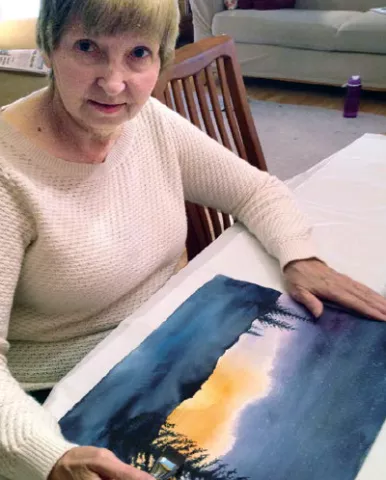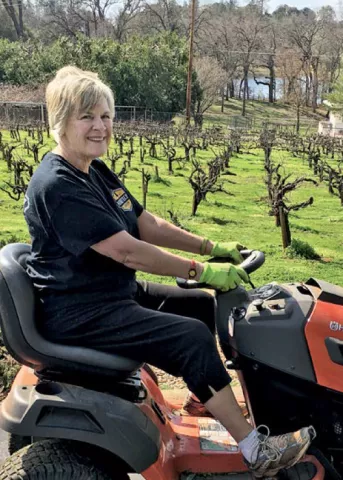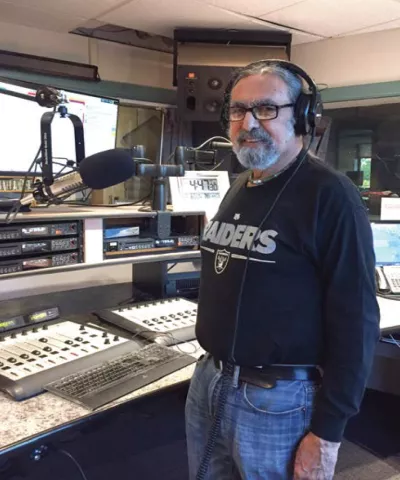
As a girl, Kris Kragelund watched her father sketch cartoons at the family kitchen table, but she didn’t think too much about it. As a cartoonist for the Spokane Review, it was his job to make people simultaneously laugh and think about current events. Still, the influence was undeniable, and when it came time to declare a major in college Kragelund chose art.
A short time later, she decided to switch gears and become certified to teach. Kragelund put away her art supplies and focused on being the best teacher she could be in the Vancouver Evergreen School District in Washington state.
Her artistic flair emerged occasionally, but perhaps just to draw a “Happy Face” on a student’s good work or doodle random figures on a legal pad during a long staff meeting. Sometimes, she would even draw a landscape, but, as she puts it today, “There was really no time for art. I’d work all day, grade papers at night, and fall into bed.” Kragelund’s art supplies were out of sight and out of mind.
When Kragelund retired in 2007, all of that changed. She no longer had a reason to wake up early to meet a school start time, nor a need to stay up late grading papers. Kragelund welcomed the changes, but she missed the students. Even more, she missed spending time with a core group of like-minded people.
At nearby Clark College, Kragelund found what she needed—a wide range of classes aimed specifically at mature learners. The school offers curious seniors a multitude of learning opportunities—from cake decorating, and understanding the stock market, to basic Spanish-speaking, and all sorts of courses in between.
But it was the visual art courses that piqued Kragelund’s interest.
After a lifetime spent in the classroom, the retired educator knew she would have an undeniably different experience entering a class as a student.
Just Breathe
Cassandra Herbert, a Maryland-based health and wellness life coach sympathizes with Kragelund’s first-day- of-school-as-a-student nervousness, and recommends several tips for tamping down butterflies. Remembering to breathe tops the list. “Breathing helps keep you in the present and has a tremendous calming effect,” she says.
To assuage her pre-class jitters, Kragelund employed a two-part strategy: She enrolled in a drawing course with a friend, and she made a simple deal with herself: If she didn’t feel comfortable in the class, she didn’t need to go back. To her delight—and to the delight of her friend—both women were warmly welcomed into the classroom of adult learners.
“When artists get together, we are very supportive of each othernurturing and supportive. The teacher too was very positive and encouraged our every move,” says Kragelund.
Needless to say, Kragelund was able to put aside the deal she made with herself, and looked forward to the next class.
A Passion Discovered
After the drawing class ended, Kragelund enrolled in a watercolor course. That’s where she discovered her passion.
“The medium can be unforgiving, but there are things you can do with watercolor that you can’t do with other mediums,” explains Kragelund. “When you work with watercolor, you have a hundred ways that you can approach a project.”
Kragelund, who went decades without picking up a paintbrush, now finds it difficult to imagine a week without an art class or day when she doesn’t work on her art. “My dining room is where I do a lot of my work; it’s covered in plastic now and an extra bedroom stores my art supplies,” she says. “I’m hooked.”
Her work is seen in galleries “here and there,” as Kragelund puts it, but she is “not terribly interested in selling her work.” For her, the internal satisfaction she gets from her art and the support she receives from her fellow artists is enough of a reward.
Kragelund proved to be a star student, but she couldn’t ignore a persistent internal pull to share with others what she learned. So in addition to guiding her 11-year-old niece with her painting, Kragelund now is the “art lady” at her former elementary school. Each week she volunteers to teach art techniques to eager second graders and their teachers. It’s something she has done for the past three years or so, and looks forward to continuing for some time. However, this time around, her presence is different. Kragelund doesn’t see herself as a teacher.
“I think we all are practicing artists. I see myself as a mentor, not a teacher,” Kragelund says. “We’re all in this together.”
How Her Garden has Grown

Betty Olson-Jones was what one might call a reluctant retiree. “I really had mixed feelings about leaving the classroom. It wasn’t until my co-teacher retired that I decided it was time,” explains Olson who taught from 1994 to 2014, and served as president of the Oakland Education Association, from 2006 to 2012.
What would she do without her curious fifth graders to keep her busy? Her own kids were grown and her husband had a number of time- consuming interests. For those like Olson-Jones who aren’t certain how they will transition from jam-packed workdays to the lazier days of retirement, Herbert—the health and wellness coach—recommends “slowing down and go within.” In other words, find out what really makes the heart sing. Guard against trying the latest fad or enrolling in classes that you think you “should” take. “Ask friends what they enjoy. Attend an introductory class—even visit a class for the first five minutes, or talk to people as they are leaving a class. The bottom line is to listen to your heart,” says Herbert.
Olson-Jones’ heart spoke to her while she was at the second home she purchased with her husband Mike in 2013—the year before Olson-Jones retired. The home is located in the Sierra Foothills outside the couple’s hometown of Oakland.
“There was a lot for us to do,” Olson-Jones says. “There’s a vineyard and an orchard, and five acres of land.” While her husband taught himself winemaking using fruit from the orchard, Olson-Jones explored the garden. That’s where listening to her heart led her toward purpose, peace, and a desire to become a student.
Though she had dabbled in gardening her entire life, Olson-Jones now had the time to focus on honing her skill. She enrolled in a nearby Master Garden program. The training is gaining in popularity throughout the country, and provides intensive horticultural knowledge. Those who complete the program use their talents to help their local communities by giving lectures, creating gardens, conducting research, and staffing garden hotlines.
Predictably, becoming a master gardener required the necessary “seeds” that teachers everywhere know reap academic success: dedication, commitment, and perseverance.
Of course, great instructors help, too. Olson-Jones and her peers found them “in spades” at an intense 16-week Master Gardening, boot camp-type class. The master gardening teachers, many of whom were from the University of California system, were experts in the fields of soil, water, insects, and more. Olson-Jones became the enthusiastic and prepared student whom she always appreciated when she was teaching.
Today, Olson-Jones is known as a “sprout.” The term refers to those who have completed the preliminary classes and who are growing in their mastery of gardening. As she plans future studies for herself, Olson-Jones also looks forward to digging into the familiar role of guiding those in search of knowledge. “My time spent in the Master Gardener program reaffirmed my methods of teaching. Being a good teacher is about asking the right questions. The program has helped me personally. I’ve discovered that I love pruning,” says Olson-Jones adding that the task is “like giving the trees a haircut.” She also enjoys watching people get excited when they find “solutions to their own gardening needs.”
While Olson-Jones continues to embrace retirement and her new role as student and volunteer, she remains a teacher at heart. “I’ve had the opportunity to teach third graders about worm composting, which was a lot of fun. I also would like to play a role in teaching young students about the importance of eating well. Nothing tastes better than a fresh tomato,” Olson-Jones says. As a master gardener, she will no doubt get the opportunity to encourage today’s students to be kinder to the land and better to their bodies; and as a former teacher, she has the know-how to easily ace those lessons.
The Beat Goes On

Unlike aspiring artist Kragelund and master gardener Olson-Jones, New Mexico native Henry Gonzales carved out time to learn a new craft while he was still teaching. In time, the control room of a local radio station felt nearly as comfortable to him as a school classroom. However, Gonzales learned even more about the ins and outs of broadcasting once he retired about a decade ago.
“From the time I started in radio until today, I have felt like one of those students who is always soaking up information. Radio changes so much, so rapidly. The technology is constantly improving, so I always feel like I am constantly learning on the job,” Gonzales says.
Gonzales is a volunteer disc jockey at a KUNM, the radio station on the sprawling adobe-influenced campus of the University of New Mexico (UNM) in Albuquerque. He hosts a Latino music program and a public affairs program.
His new gig stands in stark contrast to his years spent in teaching— first in a high school in Los Lunas, N.M., (outside of Albuquerque) and later at the Penitentiary of New Mexico in Santa Fe. Effective communication is important in education and in radio, but his workplaces of the past and present couldn’t be more different.
“In radio, you might be talking to thousands of people, but you’re basically alone in a studio. When you’re teaching students, you’re with them.
You can see when you’re connecting, and when you’re not,” says Gonzales.
Like other retirees who are now more often the “student” rather than the “teacher,” Gonzales still finds plenty of opportunities to impart knowledge. First, he enjoys educating his listeners about the rich history of Latin music, and, secondly, after he learns a new technique or aspect of technology, he makes a point of teaching the new information to a fellow volunteer.
After years of being the person in charge, does Gonzales mind being the person in the workplace who is in search of answers? “Heck no,” he laughs. “You never stop being the student, and you never stop being the teacher.”
Jackie Martin seemed to have the energy and strength of a superhero during the 19 years she worked as a school occupational therapist in the Montgomery County Public Schools (MCPS) in Maryland, but when she came home from a long day at work she often felt like she was the one who needed saving.
Hauling cumbersome equipment from school to school in her car took a toll. Frequently, Martin found that she couldn’t muster the energy in the evening to complete tasks she enjoyed—read a long book or manipulate a pair of knitting needles, for example. Over time, she accumulated piles of unread bestsellers and baskets of unused yarn.
After her 2016 retirement, Martin reclaimed her time. Finally, she could drink tea at a leisurely pace, take long, meandering afternoon walks, and spend her evenings reading and knitting.
But there was one problem: Martin didn’t really know how to knit. Sure, she could put the yarn on the needles and create the two basic stitches she had learned long ago as a child, but she realized that mastering intricate problems would require the assistance of a good teacher, so she called a local yarn shop that she had often passed while commuting.
“I feel incredibly lucky that I found a patient teacher who taught through repetition and demonstration,” says Martin. As luck would have it, Martin’s cheery, encouraging knitting instructor was a retired elementary school teacher from the same school district, MCPS, where Martin had worked.
Bound by kindred spirits, the knitting instructor’s optimism encouraged Martin when she became discouraged about not learning as quickly as she’d hoped.
Everyone knows it’s not easy to be a “beginner.” That’s especially true for educators who are accustom to being in charge. Being with those who are in the same boat can help, which is one reason group lessons are popular among the older set. Martin was among those who found comfort in company.
Like Kragelund and Olson-Jones, Martin found it was easy to make fast friends with people who shared her interests and goals. In 2015, Martin set her sights on knitting scarves for each of her family members. She reached her objective and looks forward to improving her skills.
“I love the feel of the yarn and the satisfaction of making a project for my granddaughter and other loved ones,” says Martin, who continues to schedule regular lessons with her instructor—a fellow NEA retiree.
Like scores of NEA retiree members—whether they be artists, gardeners, broadcasters, or possessor of any other talent—Martin’s experience shows that the expansiveness of the classroom never diminishes, even when a teacher retires. Those former teachers who return to the classroom as students live the life of knowledge that they had wished for each of their students along the way. For that, they are indeed teaching by example.
